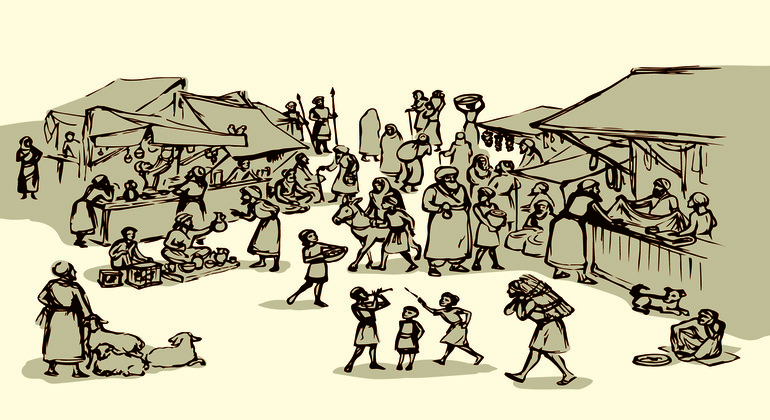In the vast expanse of human history, the concept of credit and trust in trade has been as essential as the goods getting exchanged. From the bustling markets of Mesopotamia to the modern-day MSMEs, the dynamics of credit and trust have undergone a fascinating evolution, mirroring the changing landscapes of commerce and society. This article aims to trace the evolution of trade while also discussing the similarities and differences between modern-day definitions and the older ones.
Ancient civilizations such as those in Mesopotamia laid the groundwork for credit systems by establishing intricate trade networks. In these bustling markets, initially, merchants engaged in barter. However, as trade expanded and goods became more diverse, the need for a more efficient means of exchange arose. In the Ur III period, credit played a vital role in the early Mesopotamian economy. The numerous surviving loan documents from this era provide insights into the form and function of credit, lending practices, and the activities of individual creditors. Interestingly, credit was critical at every level of society here – whether you were a shepherd tending to your flock or a merchant engaged in bustling trade, having access to credit was essential. This included both the buyer’s credit and the seller’s credit. This is how the first rudimentary forms of credit emerged, allowing merchants to defer payment until a later date, based on trust and reputation.
In medieval Europe, between the 11th and 16th centuries, guilds and merchant associations flourished. These organizations regulated trade and fostered a system of trust among members. Credit extended within these circles was on relationships and understanding. This shows how credit itself has long been a catalyst for business expansion, enabling merchants of old to leverage capital for transactions and investments. Today, such principles hold true as MSMEs and Corporates alike leverage credit facilities where SCF programs fuel growth to meet everyday business needs.
In the 18th century, merchants navigated the complexities of credit extension with a keen understanding of the importance of honor and integrity in their dealings. One such example is seen in the correspondence between Peter Tolson, a merchant in Leeds, and his son, where Tolson underscores the significance of evaluating business partners‘ honor and probity before forming partnerships. He says, “It is a very weighty affair to form partnerships and requires deliberations and enquirys. As to Mr Merac, he may or he may not be a person of honor and probity and therefore it behoves you to enter into no connections with him but what are mere commissions.” This highlights how honor, traditionally associated with the social elite, became a crucial factor in mitigating risk. Whether in ancient merchant communities or contemporary corporate environments, trust serves as the bedrock upon which partnerships are forged and transactions are conducted. The imperative of risk management has stood the test of time, albeit with notable advancements in methodology.
In the early days of commerce, credit assessment was a local affair, often termed “church steeple lending.” This term reflects the practice of granting credit within the small radius where both parties could see the local church steeple, symbolizing close-knit communities where personal knowledge and trust were paramount. Within these confined geographies, merchants and lenders relied on personal relationships, reputations, and local knowledge to assess creditworthiness, making the process straightforward and informal.
However, as trade expanded over greater distances, the need for more formalized and systematic credit assessments emerged. The anonymity and lack of personal connections in broader markets necessitated the development of standardized credit evaluation methods, leading to the establishment of credit information companies and the use of financial metrics and records. The credit information and opinion reports provided by these business information companies ensures that credit can be extended reliably and efficiently, even when the creditor and debtor are far apart and unfamiliar with each other.
It is not very different today. Every business in the supply chain still finds it necessary to know exactly with whom they are doing business, and how risky their dealings are. While the needs are the same, the process of risk assessment and the variables involved have evolved in today’s world. Modern businesses employ risk management platforms that leverage structured & unstructured data, analytics, and technology to assess and monitor credit, supplier, and compliance risk of their counterparties. These risk variables include:
- The legal identity of a business entity and its owners, ie., KYC.
- The Ultimate Beneficial Owners (UBO) of the business
- Shareholding/ownership pattern
- Statutory Compliance with Tax Laws, Company Registration, Employee Benefits etc.
- Litigation Data
- Financial Performance and its analysis
- Employee and Customer Feedback on Social Media
- Media articles (positive and negative) about the entity
While the perception of ‘honor’ may have changed, in modern times we can treat ‘honor’ as a reflection of ethical behavior, corporate social responsibility (CSR), strong corporate governance and transparency. A business that is ethical, transparent and a good corporate citizen is seen as being worthy of trust.
Looking ahead, the future of trade credit assessment will be increasingly driven by technological innovation. We have seen a massive growth in computational capability facilitating real-time data integration from diverse sources and on-the-fly risk scoring and analytics. This will provide comprehensive insights into a counterparty’s risk profile enabling more dynamic and responsive credit decisions.
Additionally, digital platforms will continue to democratize access to trade finance, allowing businesses of all sizes to secure affordable trade credit globally. These advancements will not only streamline the credit assessment process but also foster greater trust and inclusivity in international trade.








